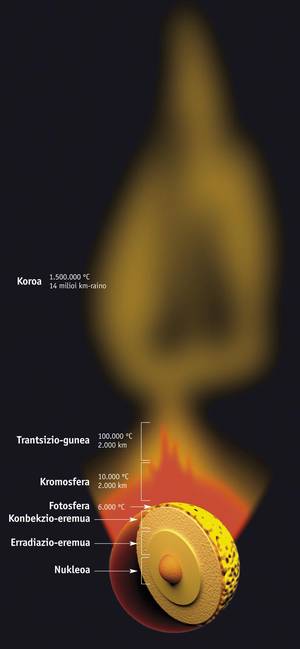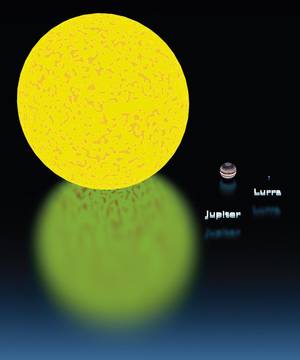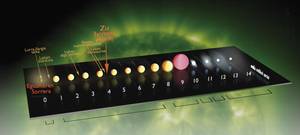Projected by magnetism

"From the astrophysical point of view, the Sun is a normal star, but being the closest to us we are very interested," says astronomer Iñigo Arrangi, from Tokyo. Indeed, Arrangi is a theoretical physicist of the IAC Institute of the Canary Islands and also studies the Sun with the Hinode probe of the Japanese Space Agency JAXA. "I collaborate in the planning and follow-up of Hinode's daily observations. Every day we review the data collected in previous hours in search of something that can be interesting".
Hinode's specialty is to look closely at the surface of the Sun, and Arrangi knows perfectly its appearance. However, it is nothing more than an appearance. The surface is observed, but it does not really exist. "The sun is a ball of gas so it has no defined surface. The visible surface in view or through optical telescopes is defined by the last layer that emits white light. That's why we call it a photosphere."
The color of the supposed surface is important, since the color of the stars depends on the temperature, like that of the pieces of iron heated to the fire. From a temperature they are placed in red, and from there they are heated to catch orange, yellow and other colors. The hottest ones are the blue stars. The Sun is yellow-white because the surface is 6,000 °C. On a scale that classifies stars according to temperature, the Sun is a star type G2: a very common star, although it is not of this type the most abundant galaxies.
In addition to color, there is something to see in that supposed surface. Thanks to the Hinode probe, Arrangi is a daily witness. "At all times it is full of millions of cellular granules, about 1,000 kilometers long and barely last a few minutes. There are also larger structures, supergranular, of about 30,000 km of length and several hours of duration". All this is a landscape carved by the magnetic field of the Sun.
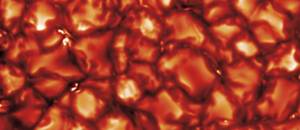
"Magnetism is the characteristic that gives the Sun a special personality," says Arrangi. The Sun, in short, is a great dynamo that creates a huge magnetic field. "The area crosses the whole star and its surroundings. On the surface, magnetism is explained by the spots that appear here and there". And these spots are like doors to the magnetic field.
On a journey from the inside of the sun out, despite leaving behind this image, the whims of magnetism do not disappear. The other way around. The area commands in everything that happens outside, which is the greatest mystery of the Sun for current scientists.
The great mystery of the Sun
Although the surface of the Sun is at 6,000 °C, the crown temperature is much higher. Millions of degrees. And, in addition, something happens in the crown, which propels the charged particles into space. Everything that escapes from the sun is heated and accelerated. But how? This is one of the great questions about the Sun.
The journey of charged particles begins in the visible photosphere at a glance. Some of them, very few, arrive on Earth, but this small amount has a great influence. It interacts violently with the terrestrial magnetosphere; the particles of great energy change form the magnetosphere. But where and how have these particles obtained energy?
The answer to question Non is known. It is at the beginning of the journey. As it ascends above the surface of the Sun, the density of gas decreases rapidly. "Magnetism dominates the physics that happens there. This area of the low atmosphere is called chromosphere. This region has a vertical width of 2,000 km, so it is a very thin area that separates the surface of the upper crown", explains Arrangi. In the chromosphere the particles are heated up to a temperature of 10,000 °C, but it is only the beginning of the effect.
From there begins the corona of the Sun, visible part of the total eclipses of Sun. "The structures of the crown are somehow related to the magnetic field that comes out of the spots on the surface, but the connection between the lower surface and the upper crown is not yet understood with sufficient precision," explains Arrangi.
Because the particles are heated and accelerated mainly in the crown, it is evident that the particles absorb energy from somewhere. And there is the mystery, how that happens.
Tornados in the Sun
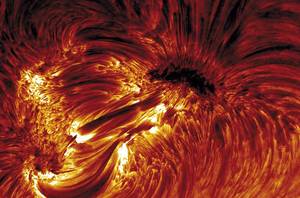
In July they published a possible explanation in the journal Nature. Astronomers at the University of Oslo have found that the answer could be in magnetic currents in the form of tornadoes. "This same year we have discovered that there are tornadoes in the Sun," says Arrangi. "These tornadoes are trailers of magnetic field lines." These trailers, together with the particles, transport energy into space. The Oslo group, through the SDO observatory, has studied stratigraphically the upward trajectory of particles.
Astronomers have detected magnetic tornadoes, which does not mean that this single process occurs throughout the crown. Because a single explanation is not enough. "If we consider each process separately, we understand it quite well. On a qualitative level, at least, they answer many questions. On a quantitative level, however, it is to be determined whether the energy that can contribute to heating and particle acceleration is sufficient."
There is a great effort to collect more data from the corona of the Sun and to provide data to researchers. There are many missions. "It's hard to give a specific number," says Arrangi. "To give an idea, at this moment we have approximately ten missions studying the Sun from space. Although some are old, even after having well overcome their initial life, they are still useful and their data are important, such as the SOHO mission. More recent ones, such as the Hinode satellite of the JAXA agency, the two NASA STEREO satellites, which allow to visualize the atmosphere of the Sun stereoscopically, or the SDO mission sent two years ago by NASA to measure the solar corona and its different temperatures. In the last decade several missions have also been designed to study the solar wind in situ: WIND and ACE, for example".
In the future, the efforts focus on two general aspects. On the one hand, observe and understand in more detail the chromium-crown dynamics through NASA's IRIS and SOLAR-C missions. On the other hand, missions will be launched that will try to know better the genesis and nature of the solar wind. "Within five years the European Agency will launch Solar Orbiter to study the solar wind and its generating points at the poles of the Sun. For this purpose it will approach a distance of 60 solar radios from the Sun. With NASA's Solar Probe Plus mission they plan to go closer to the Sun. In this case, the observatory will reach 8 solar rays (about 6 million km) on the surface of the Sun, in order to measure directly their physical conditions".
Buletina
Bidali zure helbide elektronikoa eta jaso asteroko buletina zure sarrera-ontzian




